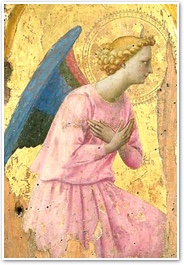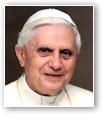Beauty, a Pathway to Prayer
- POPE BENEDICT XVI
I would like to reflect briefly on one of the channels that can lead to God and can also be of help in our encounter with him.
 The Lord himself gives us many opportunities to remember him. I would like to reflect briefly on one of these channels that can lead to God and can also be of help in our encounter with him. It is the way of artistic expression, part of that via pulchritudinis, the "way of beauty," of which I have spoken several times and whose deepest meaning must be recovered by men and women today.
The Lord himself gives us many opportunities to remember him. I would like to reflect briefly on one of these channels that can lead to God and can also be of help in our encounter with him. It is the way of artistic expression, part of that via pulchritudinis, the "way of beauty," of which I have spoken several times and whose deepest meaning must be recovered by men and women today.
It may have happened on some occasion that you paused before a sculpture, a picture, a few verses of a poem, or a piece of music that you found deeply moving, that gave you a sense of joy, a clear perception, that is, that what you beheld was not only matter — a piece of marble or bronze, a painted canvas, a collection of letters, or an accumulation of sounds — but something greater, something that "speaks," that can touch the heart, communicate a message, uplift the mind.
A work of art is a product of the creative capacity of the human being who in questioning visible reality seeks to discover its deep meaning and to communicate it through the language of forms, color, and sound. Art is able to manifest and make visible the human need to surpass the visible; it expresses the thirst and the quest for the infinite. Indeed, it resembles a door opening on to the infinite, on to a beauty and a truth that go beyond the daily routine. And a work of art can open the eyes of the mind and the heart, impelling us upward.
However, some artistic expressions are real highways to God, the supreme Beauty; indeed, they help us to grow in our relationship with him in prayer. These are works that were born from faith and express faith. We can see an example of this when we visit a Gothic cathedral: we are enraptured by the vertical lines that soar skywards and uplift our gaze and our spirit, while at the same time we feel small yet long for fullness. . . .
Or when we enter a Romanesque church, we are spontaneously prompted to meditate and to pray. We perceive that these splendid buildings contain, as it were, the faith of generations. Or when we listen to a piece of sacred music that plucks at our heartstrings, our mind, as it were, expands and turns naturally to God.
I remember a music concert of Johann Sebastian Bach in Munich conducted by Leonard Bernstein. At the end of the last passage, one of the Cantatas, I felt, not by reasoning but in the depths of my heart, that what I had heard had communicated truth to me, the truth of the supreme Composer, and impelled me to thank God. The Lutheran bishop of Munich was next to me, and I said to him spontaneously, "In hearing this, one understands: it is true; such strong faith is true, as well as the beauty that irresistibly expresses the presence of God's truth."
Yet how many pictures or frescos, fruits of the artist's faith, in their form, in their color, in their light, urge us to think of God and foster within us the desire to draw from the source of all beauty! What Marc Chagall, a great artist, wrote remains profoundly true: that for centuries painters have dipped their paintbrush in that colored alphabet that is the Bible. Thus, how often artistic expression can bring us to remember God, to help us to pray or even to convert our heart!
Paul Claudel, a famous French poet, playwright, and diplomat, precisely while he was listening in the Cathedral of Notre Dame to the singing of the Magnificat during Christmas Mass in 1886, had a tangible experience of God's presence. He had not entered the church for reasons of faith but rather in order to seek arguments against Christians, and instead, God's grace worked actively in his heart.
Dear friends, I ask you to rediscover the importance of this path also for prayer, for our living relationship with God. Towns and villages throughout the world contain treasures of art that express faith and beckon to us to return to our relationship with God. May the visits to places filled with art, then, not only be opportunities for cultural enrichment — that, too — but may they become above all moments of grace, incentives to strengthen our bond and our dialogue with the Lord so that — in switching from simple external reality to the more profound reality it expresses — we may pause to contemplate the ray of beauty that strikes us to the quick, that almost "wounds" us, and that invites us to rise toward God.
I end with a prayer from a psalm, Psalm 27: "One thing have I asked of the Lord , / that will I seek after; / that I may dwell in the house of the Lord / all the days of my life, / to behold the beauty of the Lord , and to inquire in his temple" (verse 4). Let us hope that the Lord will help us to contemplate his beauty, both in nature and in works of art, so that we, moved by the light that shines from his, may be a light for our neighbor. (General Audience, Castel Gandolfo, August 31, 2011)
 This is Meaghen Gonzalez, Editor of CERC. I hope you appreciated this piece. We curate these articles especially for believers like you.
This is Meaghen Gonzalez, Editor of CERC. I hope you appreciated this piece. We curate these articles especially for believers like you.
Please show your appreciation by making a $3 donation. CERC is entirely reader supported.

Acknowledgement
 Pope Benedict XVI. "Beauty, a Pathway to Prayer." General Audience given at Castel Gandolfo (August 31, 2011).
Pope Benedict XVI. "Beauty, a Pathway to Prayer." General Audience given at Castel Gandolfo (August 31, 2011).
Reprinted by permission of Libreria Editrice Vaticana.
The Author

 Pope Benedict XVI is the author of Jesus of Nazareth, Vol II, Jesus of Nazareth, Vol I, Caritas in Veritate: Charity in Truth, Saved in Hope: Spe Salvi, God Is Love: Deus Caritas Est,The End of Time?: The Provocation of Talking about God, Truth and Tolerance: Christian Belief and World Religions, Without Roots: The West, Relativism, Christianity, Islam, Salt of the Earth: An Exclusive Interview on the State of the Church at the End of the Millennium, God and the World: Believing and Living in Our Time, In the Beginning: A Catholic Understanding of the Story of Creation and the Fall, The Spirit of the Liturgy, The Ratzinger Report: An Exclusive Interview on the State of the Church, Introduction to the Catechism of the Catholic Church, Introduction to Christianity, Called to Communion: Understanding the Church Today, Milestones: Memoirs 1927-1977, Behold the Pierced One, and God Is Near Us: The Eucharist, the Heart of Life.
Pope Benedict XVI is the author of Jesus of Nazareth, Vol II, Jesus of Nazareth, Vol I, Caritas in Veritate: Charity in Truth, Saved in Hope: Spe Salvi, God Is Love: Deus Caritas Est,The End of Time?: The Provocation of Talking about God, Truth and Tolerance: Christian Belief and World Religions, Without Roots: The West, Relativism, Christianity, Islam, Salt of the Earth: An Exclusive Interview on the State of the Church at the End of the Millennium, God and the World: Believing and Living in Our Time, In the Beginning: A Catholic Understanding of the Story of Creation and the Fall, The Spirit of the Liturgy, The Ratzinger Report: An Exclusive Interview on the State of the Church, Introduction to the Catechism of the Catholic Church, Introduction to Christianity, Called to Communion: Understanding the Church Today, Milestones: Memoirs 1927-1977, Behold the Pierced One, and God Is Near Us: The Eucharist, the Heart of Life.




